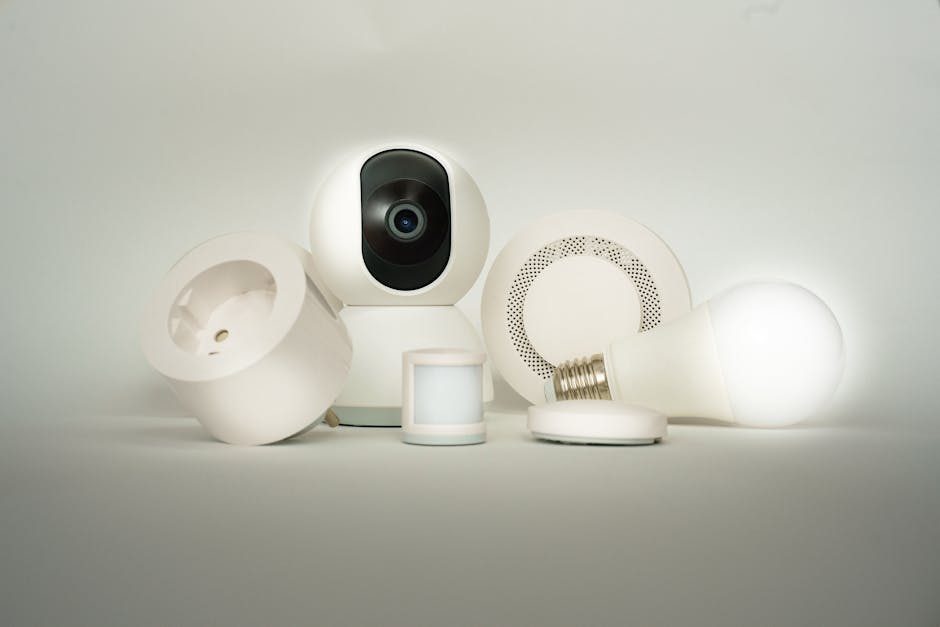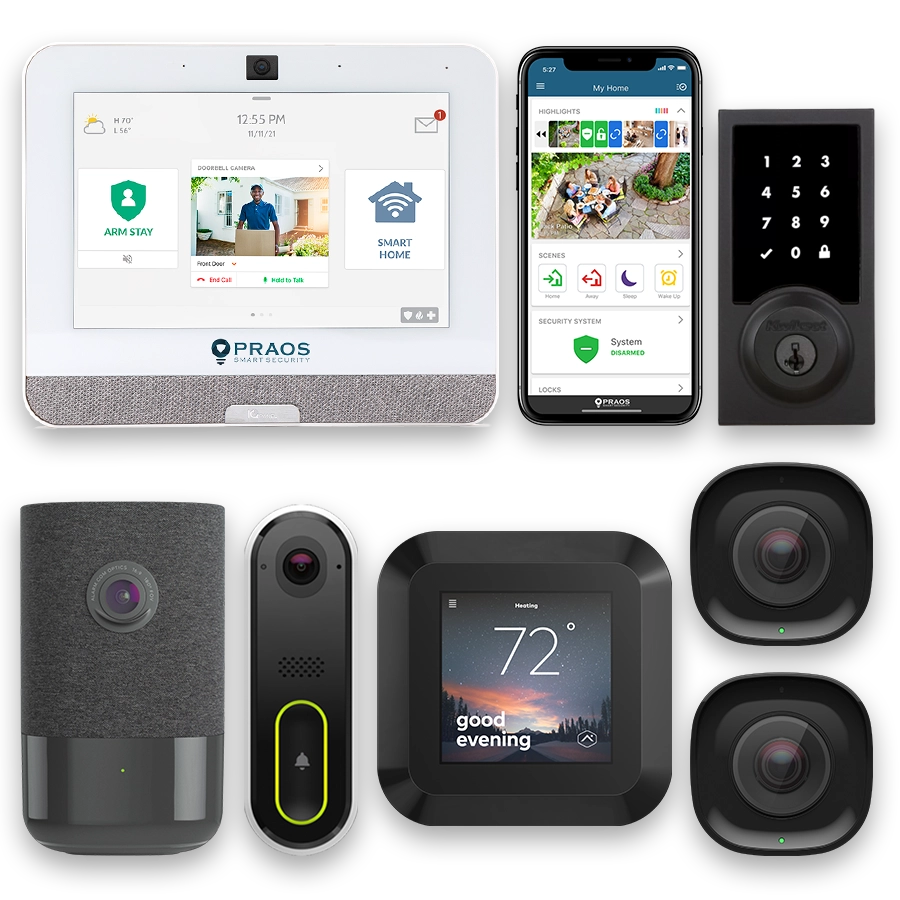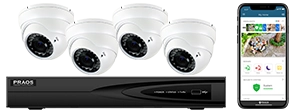- Introduction to Smart Home Security and Business Surveillance in Richmond
- Current Security Landscape in Richmond: Challenges and Needs
- Technological Advancements in Smart Security Systems
- Integrating Smart Home Security with Business Surveillance
- Effective Strategies for Comprehensive Security
- Case Studies and Real-World Applications in Richmond
Introduction to Smart Home Security and Business Surveillance in Richmond
At Praos, we’re dedicated to our most important role—ensuring the safety of your family and home. This commitment goes beyond simply setting up a security system in your home or business. With our deep understanding of the Richmond area, and an award-winning service track record, Praos stands as a leading local Richmond home security company. Our goal is to provide you with a comprehensive security solution that combines the latest smart home technology with business surveillance techniques, customized to meet your specific needs.
With years of local expertise, Praos offers a service that is both reliable and trusted by the Richmond community. When new customers opt for our monitored new system plan, they receive FREE Equipment and Free Installation. This makes adopting cutting-edge security systems more accessible.
But our efforts don’t stop there. We’re also at the forefront of creating a truly connected home experience. This means using one integrated app for security, automation, and surveillance. Our team will work closely with you to customize a smart home system tailored to your needs and budget. This comprehensive approach ensures that no matter where you are, you can have peace of mind knowing that your home is monitored and protected.
Additionally, our service plans start at an affordable $19.95 per month, enabling a wider range of families and businesses to experience high-quality security solutions.
The capabilities of integrated smart home security and business surveillance can be summarized in the following table:
| Feature | Description |
|---|---|
| Free Equipment and Installation | Offered to new customers with a monitored new system plan. |
| One Connected App | Centralized control for security, automation, and surveillance. |
| Custom Solutions | Tailored to individual needs and budgets. |
| Affordable Rates | Starting at just $19.95 per month. |
In summary, Praos leverages both advanced technology and local expertise to provide reliable, comprehensive protection for homes and businesses in Richmond. As we delve deeper into the broader security landscape and the latest technological advancements, it becomes evident that integrating smart home security with business surveillance offers a robust solution for ensuring safety and peace of mind.
Current Security Landscape in Richmond: Challenges and Needs
Richmond, like many urban areas, faces a diverse range of security challenges which necessitate robust and comprehensive solutions for both residential, and commercial properties. Understanding the current security landscape is crucial to identifying the needs and formulating strategies to address potential vulnerabilities effectively.
Crime Statistics and Trends
Analyzing recent crime statistics offers valuable insights into the types of security issues prevalent in Richmond. According to the Richmond Police Department, there was a reported increase in property crimes, including burglary and vandalism, in the past year. Residential areas saw a 10% rise in break-ins, while commercial properties experienced a 15% rise in incidents of theft and vandalism.
Specific Challenges in Residential Areas
Richmond’s residential neighborhoods face several unique security challenges:
- Burglaries: Home burglaries are a significant concern, often occurring during daylight hours when residents are away at work.
- Package Theft: An increasing issue due to the rise in online shopping, with packages left on doorsteps becoming easy targets for thieves.
- Vandalism: Instances of property defacement and other forms of vandalism are prevalent in certain areas.
Specific Challenges in Commercial Areas
Businesses in Richmond also encounter several specific security issues:
- Employee Theft: Internal theft is a persistent problem, adding significant costs to businesses every year.
- After-Hours Break-Ins: Commercial properties, especially those without robust nighttime security measures, are often targeted after business hours.
- Vandalism and External Theft: Storefronts and offices are frequently subject to vandalism and theft, impacting business operations and customer confidence.
Existing Security Measures
Various security measures have been implemented across Richmond to tackle these challenges. These include:
- Police Patrols: Increased frequency of police patrols in high-crime areas.
- Neighborhood Watch Programs: Community initiatives aimed at enhancing vigilance and reporting suspicious activities.
- Traditional Alarm Systems: Use of alarm systems and basic CCTV cameras in both residential, and commercial properties.
Despite these measures, there are significant gaps in coverage and effectiveness, particularly in integrating modern technology with traditional systems to create a seamless security network.
Identified Needs
The current landscape indicates several critical needs for improving security in Richmond:
- Advanced Surveillance Technology: Incorporation of AI-based analytics, motion detection, and high-definition video for better monitoring and threat assessment.
- Integrated Systems: Seamless integration of residential, and business security systems to provide 24/7 comprehensive protection.
- Remote Monitoring: Enhanced capabilities for homeowners and business owners to monitor their properties remotely in real-time.
- Proactive Measures: Development of proactive security measures, such as predictive analytics to pre-empt potential incidents.
By addressing these challenges with targeted strategies and leveraging technological advancements, Richmond can move towards a more secure environment for both its residents and businesses.
Technological Advancements in Smart Security Systems
3. Technological Advancements in Smart Security Systems
The field of smart security systems has seen significant technological advancements in recent years, driven by the need for enhanced surveillance and protection capabilities. These advancements offer improved accuracy, efficiency, and convenience for both home and business security systems.
Artificial Intelligence and Machine Learning: AI and machine learning are revolutionizing smart security systems. They enable devices to learn from data patterns and improve their performance over time. For instance, facial recognition systems utilize AI to distinguish between familiar and unfamiliar faces, thereby reducing false alerts.
Internet of Things (IoT): The integration of IoT in security systems allows various devices to communicate with each other, creating a cohesive security network. This interconnectedness enables real-time monitoring and control through smartphones and other devices, providing users with immediate access to security footage and alerts.
Cloud Computing: Cloud-based security solutions facilitate the storage and retrieval of vast amounts of data. This ensures that video recordings and other security data are securely stored off-site, reducing the risk of data loss due to physical damage or tampering. Additionally, cloud computing enables scalable solutions, allowing users to easily expand their storage and processing capabilities as needed.
High-Definition and 4K Cameras: The deployment of high-definition and 4K cameras enhances the quality of surveillance footage, enabling clearer identification of individuals and events. These cameras often come equipped with night vision and wide-angle lenses, providing comprehensive coverage in various lighting conditions.
Smart Sensors and Detectors: Modern security systems incorporate advanced sensors and detectors that can identify a range of threats, from motion and sound to smoke and carbon monoxide. These sensors are integral to smart home security, offering early warnings and facilitating prompt responses to potential hazards.
Wireless Technology: Wireless security systems offer numerous advantages, including ease of installation, flexibility in device placement, and reduced risk of tampering. Wireless systems can also be easily integrated with existing smart home or business networks, enhancing overall security infrastructure.
Mobile Integration: The ability to control and monitor security systems through mobile apps provides users with enhanced convenience and peace of mind. Mobile integration allows for real-time alerts, live video feeds, and remote control of security devices from anywhere, ensuring continuous protection.
These technological advancements have significantly improved the capabilities of smart security systems, offering more robust and user-friendly solutions for both residential, and commercial properties.
Integrating Smart Home Security with Business Surveillance
The integration of smart home security with business surveillance is a valuable approach towards achieving comprehensive protection in Richmond. Both systems share similar objectives: deterrence, detection, and response to security threats. Combining these technologies can offer several advantages, enhancing overall safety for both residential, and commercial properties.
One key benefit of integration is the centralization of security monitoring. By using unified platforms, property owners can oversee multiple locations from a single interface. This streamlines the process, allowing for more efficient management and quicker response times. Many modern security solutions offer apps and, web portals that consolidate data from various sources, providing a cohesive overview of security statuses and alerts.
Compatibility between devices is another critical aspect. Smart home devices, such as cameras, motion sensors, and entry alarms, can be seamlessly integrated with more robust business surveillance systems. This interoperability ensures that all devices work together harmoniously. Common industry standards like Z-Wave and Zigbee facilitate this integration, enabling communication between different manufacturers’ devices.
Enhanced data analytics is a significant advantage of combined systems. Integrative platforms often feature sophisticated analytics tools that can identify patterns and irregularities. These tools help in predictive analysis, allowing for proactive security measures. For instance, understanding the movement patterns within a property can optimize the placement of cameras and sensors to minimize blind spots.
There are also practical benefits to shared infrastructure. Utilizing the same network and storage systems for both home and business security can reduce costs. It eliminates the need for separate systems, lowering installation and maintenance expenditures. Moreover, advancements in cloud technology offer scalable solutions, making it easier and more economical to expand security coverage as needed.
Increasing synergy between home and business security systems may also result in better emergency response coordination. Centralized systems can expedite communication with law enforcement and emergency services, providing precise information promptly. This collaboration enhances the effectiveness of security responses, potentially mitigating the impact of security breaches.
Additionally, the use of integrated systems brings the advantage of redundancy. When different types of sensors and cameras are used collectively, it ensures multiple layers of detection. If one aspect of the system fails or is compromised, others can still function effectively, offering robust protection. This redundancy is crucial in creating a resilient security network.
Lastly, integration supports scalability and future-proofing. As new technologies emerge, integrated systems can adapt more readily. Property owners can incorporate innovative solutions without overhauling the entire security system, ensuring long-term effectiveness and staying ahead of potential threats.
Effective Strategies for Comprehensive Security
To achieve comprehensive security through the integration of smart home and business surveillance systems, several effective strategies must be employed. These strategies focus on enhancing the synergy between various technologies, ensuring robust coverage, and maintaining adaptability to evolving threats.
1. Comprehensive Risk Assessment
A foundational strategy involves conducting a thorough risk assessment. This includes identifying potential threats, vulnerabilities, and critical assets. Security experts recommend performing regular and detailed evaluations to understand the unique security needs of both residential, and commercial properties in Richmond.
Key steps in risk assessment:
- Identify and categorize assets.
- Determine potential threats and vulnerabilities.
- Evaluate the existing security measures and identify gaps.
- Formulate a comprehensive security plan tailored to identified risks.
2. Integration of Surveillance Technologies
Integrating various surveillance technologies can provide layered security and enhanced monitoring capabilities. This method ensures multiple points of security through the use of cameras, motion detectors, and alarm systems. When these systems are interconnected, they can deliver real-time alerts and comprehensive coverage.
Integration techniques include:
- Utilizing IP cameras for high-definition video capture and remote monitoring.
- Incorporating motion detectors to trigger cameras and alarms.
- Setting up alarms that activate upon detecting unauthorized access.
3. Centralized Monitoring and Control Systems
A centralized monitoring system consolidates data from various security devices into a single interface, making it easier to manage and respond to incidents. Such systems allow for streamlined oversight and immediate action in case of emergencies.
Advantages of centralized control:
- Real-time monitoring and quick response capabilities.
- Comprehensive data collection and analysis.
- Reduced complexity in managing multiple devices.
4. Utilization of Artificial Intelligence and Machine Learning
Artificial Intelligence (AI) and Machine Learning (ML) are revolutionizing the security landscape by providing advanced analytics and predictive capabilities. These technologies can identify patterns, detect anomalies, and predict potential security breaches, enhancing preventive measures.
AI and ML applications in security:
- Facial recognition for enhanced access control.
- Behavioral analytics for identifying suspicious activities.
- Anomaly detection to forecast and prevent security incidents.
5. Regular Maintenance and Updates
Consistent maintenance and updates of security systems ensure their optimal performance and adaptability to new threats. This includes software updates, hardware checks, and regular system audits.
Maintenance best practices:
- Schedule regular system checks and updates.
- Keep software and firmware up-to-date to patch vulnerabilities.
- Conduct periodic audits to assess system performance and compliance.
6. Employee and Resident Training
Educating employees and residents about the security systems in place and training them on how to respond to incidents is crucial. Awareness and preparedness can significantly enhance the effectiveness of security measures.
Training initiatives:
- Conduct regular workshops and drills.
- Distribute educational materials and updates on security protocols.
- Implement emergency response training programs.
7. Collaboration with Local Authorities
Collaborating with local law enforcement and emergency services can provide additional layers of security and quicker response times. Establishing communication channels and protocols for sharing information ensures a coordinated approach to security in Richmond.
Collaborative efforts include:
- Establishing direct lines of communication with local authorities.
- Sharing surveillance data and insights with law enforcement.
- Participating in community policing initiatives and safety programs.
By implementing these strategies, both residential, and commercial properties in Richmond can achieve a comprehensive and integrated approach to security, addressing current and emerging threats effectively.
Case Studies and Real-World Applications in Richmond
The practical application of integrating smart home security and business surveillance systems can be illustrated through various real-world examples from Richmond. These case studies highlight the successful deployment of advanced security technologies in both residential, and commercial settings.
Residential Case Studies: Enhanced Home Security
Several homeowners in Richmond have integrated smart home security systems featuring surveillance cameras, motion detectors, and remote monitoring capabilities. For instance, the implementation of Ring doorbell cameras and ADT smart security solutions has significantly reduced incidents of package theft and home invasions. According to the Richmond Police Department, neighborhoods with a high adoption rate of these technologies have seen a decrease in burglary rates by up to 15% over the past year.
- Ring doorbell cameras allow homeowners to monitor and communicate with visitors remotely, enhancing entry-point security.
- ADT smart security systems offer comprehensive monitoring with features like motion sensors, automated locks, and real-time alerts.
Moreover, community-wide initiatives like the ‘Neighbors’ app by Ring enable residents to share security footage and alerts, fostering a cooperative environment in the neighborhood. This community-driven approach has been instrumental in addressing local security concerns more promptly and efficiently.
Commercial Case Studies: Business Surveillance Solutions
In the commercial sector, businesses in Richmond have increasingly adopted integrated surveillance systems to safeguard their premises. Retail stores, offices, and warehouses have benefited from the installation of high-definition CCTV cameras, access control systems, and advanced alarm systems. For example, a well-known retail chain in downtown Richmond reported a 20% drop in shoplifting incidents after upgrading to a surveillance system powered by Hikvision technology, which includes intelligent video analytics to detect suspicious activities.
- Hikvision CCTV systems provide high-resolution video capture with features such as facial recognition and motion detection.
- Access control systems like those from Honeywell offer businesses secure entry management, ensuring only authorized personnel can access critical areas.
Additionally, the integration of business surveillance with smart home technology has enabled business owners to remotely monitor their stores through mobile apps, ensuring real-time oversight regardless of their location. This connectivity has proven essential for immediate incident response and overall operational efficiency.
Public Safety and Community Impact
Richmond’s municipal agencies have also embraced advanced surveillance solutions to enhance public safety. The Richmond City Government has installed hundreds of surveillance cameras across key public areas, such as parks and public transit stations, managed through a central monitoring system. This deployment has been pivotal in reducing vandalism and improving emergency response times.
The combination of smart home security and business surveillance systems, supported by public infrastructure, creates a robust security network across Richmond. This collaborative effort between residents, businesses, and municipal authorities contributes to a safer and more secure community.





